by Winding Pathways | Feb 2, 2023 | Foraging, Nature, Pests, Trees, Trees/Shrubs
Disappearing Ash Trees
Ash trees are fast disappearing from American forests and towns. It’s tragic.
There are several ash species, including white, green, blue, and black. A Chinese native insect, the Emerald Ash Borer, is killing them all quickly. It’s awful.
Years ago, Dutch Elm Disease cleared cities of American elms, and many homeowners and towns planted green and white ash trees to replace them. Ashes, in general, thrive in the woods and towns. They grow relatively quickly, resist storm damage, and are beautiful. They seemed like an ideal urban tree.
That was true until Emerald Ash Borers were found in Michigan in 2002, although they may have been around at least a decade earlier. Since then, the insect has spread like crazy, killing ashes radiating outward from Michigan.
They reached Iowa years later and have since killed most of the trees in Cedar Rapids, area woodlands, and many other towns.
Salvaging Ash trees
Rich salvages wood from a scrap pile of used pallets. Pallets are made from cheap wood, like cottonwood, poplar, and hackberry, but now he’s finding ones made of ash.
Loggers are salvaging dead and dying ash trees, and the wood is cheap, at least for now. Soon ash lumber will no longer exist.
A Versatile Wood
Sports fans will miss ash wood. It makes the best baseball bats and has been used for gymnastic bars.
Ash also is crafted into gorgeous furniture.
We lost our big ash tree in the August 2020 derecho, but it was already infested with borers with its days numbered. Sadly, we cut the tree up but gave it a second task. It harvested solar energy and used it to make wood. That wood is now being fed, piece by piece, into our woodstove. It’s keeping our home warm, but we’d rather have our tree.
-
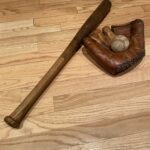
-
Ash bat on oak floor.
-
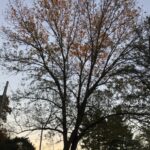
-
The ash tree anchored our east corner of the property.
-

-
White Ash bats will soon be a memory as these elegant trees die.
by Winding Pathways | Jan 5, 2023 | (Sub)Urban Homesteading, Garden/Yard, Nature, Trees/Shrubs, Weeds
A raging blizzard roaring over Winding Pathways just before Christmas showed us the power of HARVESTING SNOW. We love catching it.
Well, we didn’t really catch the snow, but our prairie did. It has a talent for harvesting snow and other forms of moisture. It taught us how prairie and other taller plants – grasses, forbs, shrubs, vines, and trees – help themselves grow next summer.
Our prairie has a thick growth of two-foot-tall dead stems from last summer’s growth. Each stalk is brittle, but thousands of them working together slowed the wind just enough for it to drop the snow it had swept off nearby lawns and roads.
The deep drift that settled on our prairie will melt and give next spring’s plants a jumpstart in moist soil. Nearby shortly sheared lawns can’t catch snow and will start the spring on dryer soil. Nature delivered irrigation water to our yard for free!
Nature’s Wisdom in Harvesting Snow
Growing up in the East, we are used to Nor ‘easters that pummel the landscape and create great skiing conditions. Until we moved west, we were not so familiar with how nature replenishes soil moisture, well, naturally!
In dry areas snow also helps next summer’s vegetables. During college, Rich worked weekends at an Idaho ranch. He was surprised one January when Lucille Pratt, part owner of the land and an outstanding vegetable gardener, asked him to shovel snow from a nearby drift onto the garden.
For a Jersey boy, this seemed like a weird request, but melting snow oozed water into the soil. That helped get the vegetables going and sustain them through the dry summer.
Snow may seem like a bother but it’s also a blessing to dry soil and the plants it sustains.
Over two blizzardy days, our prairie gently caught snowflake after snowflake. We already are looking forward to bright prairie flowers dancing in next summer’s breeze. Thanks, prairie for harvesting snow. Nature’s wisdom to catch winter’s snow and help next summer’s growth is amazing.
-
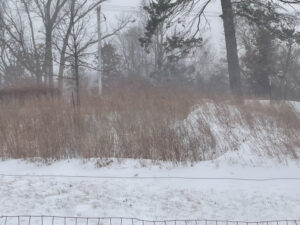
-
Capturing snow.
-
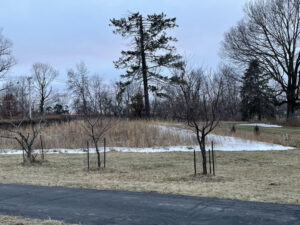
-
Three days later, a rapid melt left the ground bare, except where prairie plants held snow.
by Winding Pathways | Sep 9, 2021 | Garden/Yard, Nature, Pests, Trees/Shrubs
We’ve got a peach problem.
Iowa’s frigid winters don’t favor peach trees, but we’ve got a tough one in the front yard that’s withstood temps down to 30 below zero. Each May it graces our yard with pink blossoms that transform into smallish, tasty peaches that ripen around Labor Day.
We love peaches. So do deer. That means that every fall we play a waiting game with them.
Peaches look ripe a few weeks before they truly soften and ripen. When they’re hard as stones they don’t taste good. We know it. So do the deer. This starts the tricky part.
When will they be ready to pick? If we don’t harvest them at just the right time the deer will do it for us. They’ll devour every single one the night before we intend to pick. This year we ran a wide circle of wire mesh around our tree, but we know hungry deer will figure out how to foil it.
-
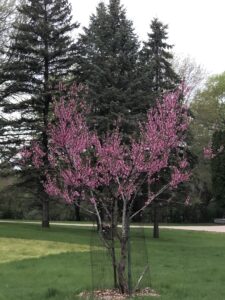
-
Each spring the fragrant pink blossoms grace our yard.
-
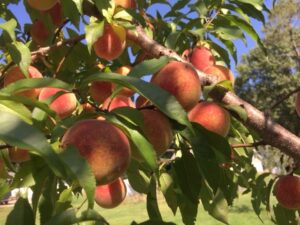
-
Deer sense when peaches are ready to eat.
As we write this on September 2nd our peaches are still hard. The deer are watching and waiting. We know because we found fresh scat just outside the wire fencing last night. We’ll let our readers know who gets the harvest.
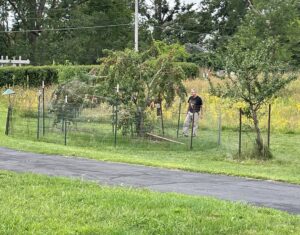
Adding extra fencing and stakes may keep the deer back.
by Winding Pathways | Mar 18, 2021 | (Sub)Urban Homesteading, Birds, Garden/Yard, Nature, Trees/Shrubs
March is a pivot month. It’s neither winter nor spring. Often called “mud season”, March is maple syruping time, but it’s also birdhouse building month at Winding Pathways.
As humans in northern climates wade through mud and long for spring, millions of birds far to the south are planning their long migration north. A few hardy waterfowl arrive as soon as the ice melts from lakes and ponds, but most birds appear, as if by magic, in April and May. We make sure our birdhouses are up before they arrive.
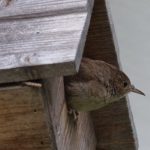
Looking out at the world.
House Wrens, Eastern Phoebes, American Robins, House Sparrows, and House Finches all nest on or near homes, barns, and garages. Although few people enjoy seeing messy House Sparrow nests tucked into nooks and crannies, most love hosting the native species as they raise the new generation outside the window.
Make Birdhouses
March is the best month to make birdhouses and restore older ones somewhat worse for the wear. Most are easy to build using simple carpentry tools. Better yet, birds aren’t fussy. Although the size of the house and the diameter of the entrance hole is important, the residents don’t care if the maker is an excellent carpenter or a novice. So, if the joints don’t fit perfectly it won’t bother birds!
Helping children make birdhouses is a fun project that involves them in nature as they learn safe tool use and basic construction techniques.
We scrounge a nearby pallet pile for free wood. Often the discarded pallets are made from boards the right width for our houses. Relatively inexpensive pine, spruce, or fir work for people who prefer to buy wood.
-
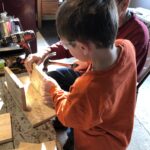
-
Working with children to make a birdhouse is rewarding.
-
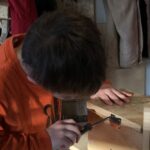
-
Children learn wood types, stages of building and how tools work.
-
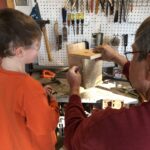
-
The birdhouse is nearly complete.
Great Resources to Guide Your Work
The best information source for virtually anything about wild birds is the Cornell University Laboratory of Ornithology. Their website gives great information on many aspects of birds, including what species likely live in an area. The site is complex but fascinating. A second website, also by the Lab, is more specific to birdhouses and nesting. The Laboratory of Ornithology site helps anyone predict what birds might migrate to their yard and when they’ll arrive. It also includes plans on how to build birdhouses. There’s even a video showing construction tips.
There’s more to birdhouses than just making one. They must be erected in the right place and height above the ground. The Lab’s website provides the right information. And, here are two tips from Winding Pathways.
Tips from Winding Pathways
- Many birdhouse plans to use nails as a hinge so the house can be opened for cleaning. We buy and use small hinges, hooks, and eyes to make opening the box to clean it easier.
- It’s tempting to attach a birdhouse to a tree using a nail or screw. That may work but eventually, the birdhouse falls off. But, the metal remains embedded in the tree. This creates danger as the tree grows around the metal, hiding it. Hitting a nail with a chainsaw is downright scary and dangerous. Also, driving a nail into a live tree can introduce diseases that could kill it. We use wire or rope to attach our birdhouses to live trees and use screws to attach birdhouses to nonliving posts and poles. One of our wren houses is suspended from a hook screwed into our porch ceiling.
Building birdhouses and enjoying a wren couple raises a brood is a fun family activity that we never tire of.
by Winding Pathways | Dec 10, 2020 | (Sub)Urban Homesteading, Garden/Yard, Nature, Trees, Trees/Shrubs
Unusual Storm Clouds
The August storm looked like an ordinary thunderstorm approaching. Dark clouds gathered to the west as we sat on our porch. What happened minutes later was far from normal.
The roaring wind hit like a prize fighter’s fist, bending our small oaks and maples parallel to the ground. Before it struck, we had 53 mature, healthy trees on our two acres. Forty minutes later only six still stood somewhat unravaged. As we watched in dismay and horror our oaks, hackberries, cherries, pines, and Douglas Firs either uprooted or snapped off. At least our beloved black walnut still stood on the edge of the woods.
Then a massive gust later reported to be 140 miles an hour by the National Weather Service, stripped off the walnut’s branches. Soon, the wind calmed, allowing us to see tree carnage and home damage. It was shocking and started three months of clean up and reconstruction. We fixed the house but it’s not possible to replace century-old trees.
A Banner Day
In contrast to the August 10, 2020 derecho, Thursday, November 19 was a banner day.
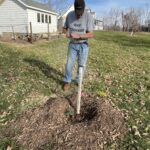
Arbor Day in November
We had just received a box of trees from the National Arbor Day Foundation. After we tucked the oaks, maples, pines, and aspens into the ground we ringed them with a thick layer of wood chips and gave them a good drink of water. The chips came from massive fallen trees the City of Cedar Rapids ground up after the storm. Then we circled each tree with wire mesh to protect it from hungry deer. By afternoon we were tired but elated. We won’t live long enough to see our new trees as giants, but we gave them a good start.
Arbor Day Quality Trees
The baby trees looked great. It was our most recent purchase from the Arbor Day Foundation. Although inexpensive, they looked healthy and eager to grow. Even the bur and white oaks, which have robust and long taproots looked great.
In most places, Arbor Day is celebrated in late April. We’ll plant some more trees then, but we sat on our back deck on a warm November evening and enjoyed seeing our trees in their new homes. For us and our new trees, it was Arbor Day in November.
Lied Lodge and Arbor Day Foundation – Destination
We have visited the Arbor Day Foundation in Nebraska City, Nebraska, several times. It’s where Arbor Day was created. We’ve overnighted at Lied Lodge on the property and enjoyed walking trails on Arbor Day Farm.
So, if you need to buy trees check out arborday.org. Want a pleasant place to visit? The Farm and Lodge are less than an hour’s drive south of Omaha. Although we’ve been there several times, we look forward to returning.
by Winding Pathways | May 30, 2019 | (Sub)Urban Homesteading, Flowers/Grasses, Garden/Yard, Garden/Yard, Nature, Trees/Shrubs
Enjoying a Welcoming Yard
On the evening of May 17th, one of nature’s brightest colors greeted us at Winding Pathways. It was a brilliant male scarlet tanager, a somewhat rare bird that we only see briefly each May.
The next morning, he was joined by a female, and we assume they’ll nest in Faulkes Heritage Woods that adjoins our property. Tanagers are birds of the big woods, and they’ll find comfortable lodging in the big oaks nearby.
We bought Winding Pathways ten years ago partly because it adjoins the 110-acre Woods protected from development by a conservation easement. It’s mostly steep land that drops down to Indian Creek about a quarter of a mile from our home.
Creating a Welcoming Yard
Since we bought our land, we’ve diversified the yard by restoring prairies and increasing the variety of savanna and woodland wildflowers in shady areas, used prescribed fire to reduce exotics, and installed many birdhouses and feeders. Thanks to the nearby woods and our more open prairie yard with the savanna in between, we enjoy a rich array of bird species. Some, like woodpeckers and chickadees, stay around all year but more migrate to nest here or stop by on their trek to nest further north. We keep a running list of the birds we see from our dining room table each spring. Some we just see winging over but many stop to eat and rest.
-
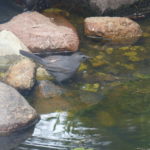
-
Catbird by water
-
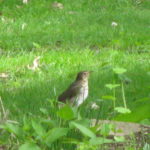
-
The Swainson’s Thrush moves through in the spring.
-
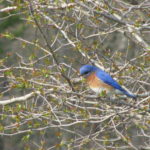
-
Bluebird in tree
Growing Bird List
We’re adding to this list daily but here’s what we’ve spotted and heard so far in May 2019:
Great Blue Heron, Barred and Horned Owl, Canada Goose, Black Capped Chickadee, Tufted Titmouse, Cardinal, White and Red Breasted Nuthatch, Downy, Hairy, Red Bellied, Red Headed, and Pileated Woodpeckers and Flicker, Turkey Vulture, House Sparrow, Wild Turkey, Red Breasted Grosbeak, Northern Oriole, Wood Duck, Common Yellowthroat, Indigo Bunting, Yellow Warbler, Louisiana Waterthrush, Blackpoll Warbler, Yellow Rumped Warbler, Scarlet Tanager, Eastern Kingbird, Phoebe, Great Crested Flycatcher, Cooper’s Hawk, Bald Eagle, Cowbird, House Sparrow, Starling, House and Carolina Wren, House Finch, Red Tail Hawk, Cooper’s Hawk, Crow, Pelican.
-
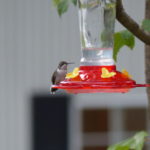
-
A hummer at the feeder.
-
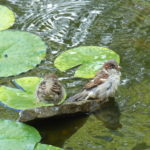
-
A water source helps attract birds.
-
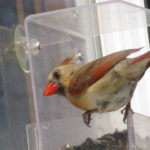
-
Female Cardinal at window feeder.
And the list keeps growing. You, too, can create a welcoming yard. This introductory YouTube video from Canada gives a quick overview of the important elements in attracting birds to a yard. It’s totally “Homegrown” and short. You can create welcoming space on a condominium patio, at a retirement or nursing home, an urban lot or spacious acreage.
Another YouTube video explains how to bring natural elements together to create natural areas. In this case, a “forest.” Again, from large scale to small we can all do this! We would, naturally, adapt to our region of the country and world. The concepts are similar.
What to Consider When Creating a Welcoming Yard
How much time/money do you want to invest?
Do you want to create a naturalistic landscape with native plants?
Do you want to harvest food from the space?
Are your neighbors tolerant of change?
What local codes affect what you want to do? (Ordinances or Covenants)
How prevalent are deer in the neighborhood?
How long do you plan to live in the home?
-
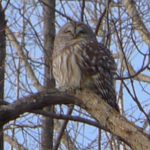
-
Waiting
-
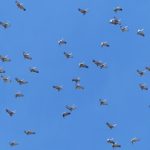
-
Wheeling overhead
-
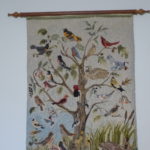
-
A hooked rug by Yvonne Fellows
We’re lucky to have Indian Creek and Faulkes Heritage Woods near Winding Pathways, but even yards not adjacent to natural areas can increase bird variety by creating diverse habitat. Spring is the best season to plant prairies and shrubs! Learn more about birds, their habits and habitats at the Cornell Laboratory of Ornithology.
-
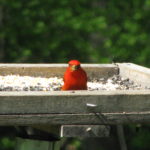
-
Extra nutrition at the feeder.
-
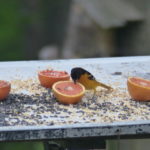
-
A male northern oriole
-
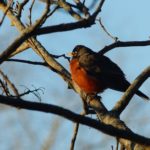
-
A robin surveys the area

























